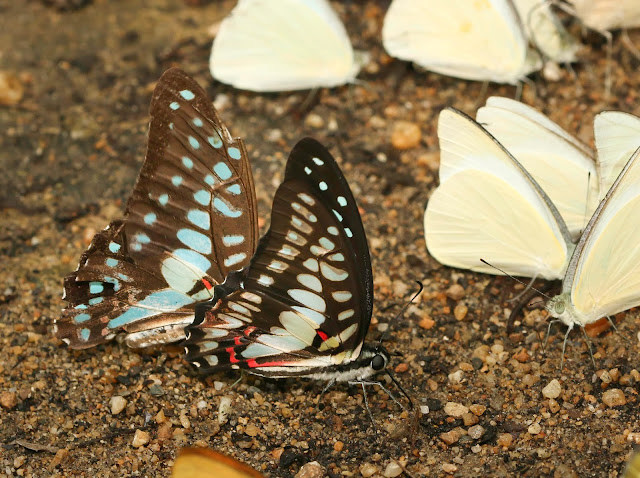Number: 238
Family: Papilioniidae
Sub-Family: Papilioniinae
Sub-Family: Papilioniinae
Species: Graphium eurypylus cheronus (Fruhstorfer, [1903])
Common name(s): The Great Jay
Photography locations: Xuan Son N.P. (Phu Tho Prov.), Tam Dao (Vinh Phuc Prov.)
With at least 104 species, Graphium is the second largest genus in the Papilioniidae family - the first one being Papilio with around 210 species. But unlike Papilio, no Graphium species are known from the Neotropical and Nearctic ecozones. Photography locations: Xuan Son N.P. (Phu Tho Prov.), Tam Dao (Vinh Phuc Prov.)
Monastyrskii & Devyatkin (2016) listed 20 Graphium species recorded in Vietnam viz. cloanthus, sarpedon, doson, evemon, eurypylus, chironides, leechi, arycles, agamemnon, phidias, macareus, megarus, xenocles, agetes, antiphates, aristeus, nomius, mullah, mandarinus, eurous.
Graphium eurypylus is one of the most wide-ranging Graphium - from India to Australia, range similar to that of G. agamemnon and G. sarpedon. Many subspecies have been described, G. e. cheronus is known from Sikkim to Indo-China, South China.
G. eurypylus is my 8th Graphium species seen in Vietnam.
Graphium eurypylus (center of the pic) and Graphium doson axion (+ some Appias albina) puddling on a sandy river bank at Xuan Son N.P. (August 2016)
Graphium eurypylus puddling with Appias galba and Appias albina (+ blurry Ixias pyrene in the top left corner) - Cuc Phuong, July 2016
A nice variety of puddling butterflies at Xuan Son National Park - June 2014
1 Graphium antiphates (Fivebar Swordtail), 2 Papilio nephelus chaon (Yellow Helen), 3 Papilio protenor euprotenor (Spangle), 4 Hebomoia glaucippe (Great Orange Tip), 5 Appias galba (Indian Orange Albatross), 6 Vindula erota (Common Cruiser), 7 Cepora nadina (Lesser Gull), 8 Prioneris thestylis (Spotted Sawtooth), 9 Appias lyncida (Chocolate Albatross), 10 Graphium sarpedon (Common Bluebottle), 11 Graphium eurypylus (Great Jay), 12 Graphium chironides (Veined Jay), 13 Papilio memnon (Great Mormon)
Graphium eurypylus is distinguished from the very similar G. doson by the black bar holding the red spot in S8 on the underside of the hindwing joining the black anal submarginal stripe near the base of the cell in a Y. In G. doson this black bar is clearly separate from the black submarginal stripe
A nice variety of puddling butterflies at Xuan Son National Park - June 2014
1 Graphium antiphates (Fivebar Swordtail), 2 Papilio nephelus chaon (Yellow Helen), 3 Papilio protenor euprotenor (Spangle), 4 Hebomoia glaucippe (Great Orange Tip), 5 Appias galba (Indian Orange Albatross), 6 Vindula erota (Common Cruiser), 7 Cepora nadina (Lesser Gull), 8 Prioneris thestylis (Spotted Sawtooth), 9 Appias lyncida (Chocolate Albatross), 10 Graphium sarpedon (Common Bluebottle), 11 Graphium eurypylus (Great Jay), 12 Graphium chironides (Veined Jay), 13 Papilio memnon (Great Mormon)
If you look closely at this image you can see 5 Graphium species (1 eurypylus, 2 chironides, 3 sarpedon, 4 doson, 5 antiphates), 4 Papilio species (6 polytes, 7 memnon, 8 nephelus chaon, 9 protenor euprotenor) and 4 Pierid species (10 Cepora nerissa, 11 Appias lyncida, 12 Appias albina, 13 Prioneris thestylis)
 Puddle party at water seepage on a rocky slope at a riverbank (Tam Dao foothills, mid-June 2016) with 5 Papilio species (1 nephelus chaon, 2 helenus, 3 bianor gladiator, 4 polytes, 5 memnon) + Graphium eurypylus cheronus (6)
Puddle party at water seepage on a rocky slope at a riverbank (Tam Dao foothills, mid-June 2016) with 5 Papilio species (1 nephelus chaon, 2 helenus, 3 bianor gladiator, 4 polytes, 5 memnon) + Graphium eurypylus cheronus (6)
 Puddle party at water seepage on a rocky slope at a riverbank (Tam Dao foothills, mid-June 2016) with 5 Papilio species (1 nephelus chaon, 2 helenus, 3 bianor gladiator, 4 polytes, 5 memnon) + Graphium eurypylus cheronus (6)
Puddle party at water seepage on a rocky slope at a riverbank (Tam Dao foothills, mid-June 2016) with 5 Papilio species (1 nephelus chaon, 2 helenus, 3 bianor gladiator, 4 polytes, 5 memnon) + Graphium eurypylus cheronus (6)
Another puddle party, from Cuc Phuong (July 2016), with 4 Graphium species (1 eurypylus, 2 macareus, 3 doson, 4 antiphates), 5 Pierid species (5 Appias albina, 6 A. galba, 7 A. indra, 8 Catopsilia pomona, 9 Prioneris thestylis)
Mud-puddling is one of the most fascinating butterfly behaviour to watch, especially in protected areas where hundreds sometimes thousands of individuals gathering at wet places. Not all butterflies species gather at mud puddles and it is a behaviour that is still not fully understood. The majority of specimens found near mud are males and quite often, while the butterfly blokes are drinking from the mud, fluids are pumped out of their abdomens.
It is believed that butterflies congregate on mud and other such substances primarily for salts. The salts and amino acids absorbed during mud-puddling play various roles in butterfly ecology, ethology and physiology. Males seem to benefit more from the sodium uptake as it aids in reproductive success, with the precious nutrients often transferred to the female during mating. This extra nutrition helps ensure that the eggs survive.
Typically, mud-puddling behavior takes place on wet soil. But even sweat on human skin or clothes may be attractive to butterflies.





No comments:
Post a Comment